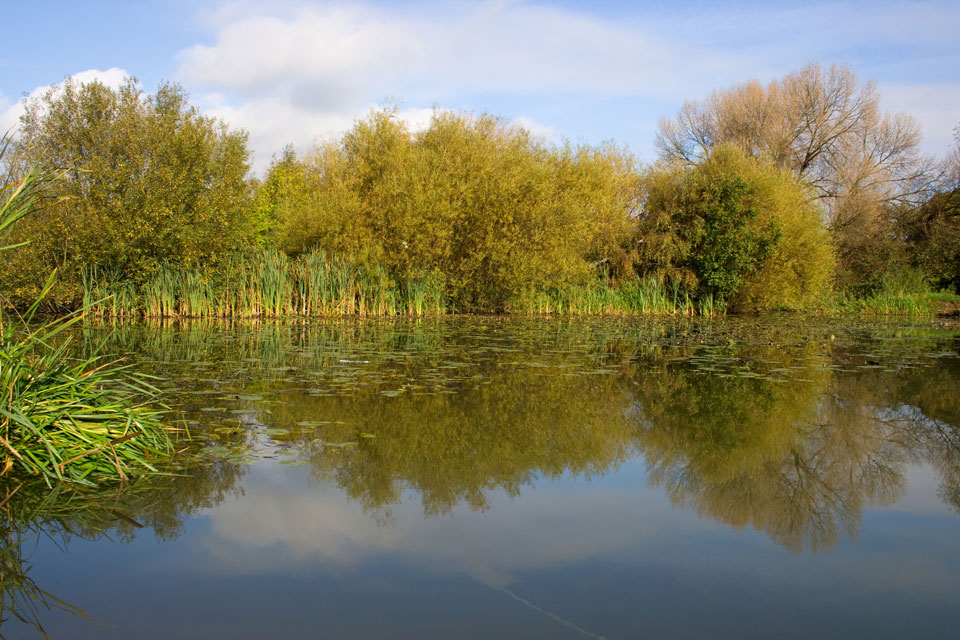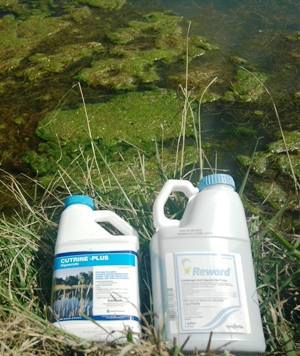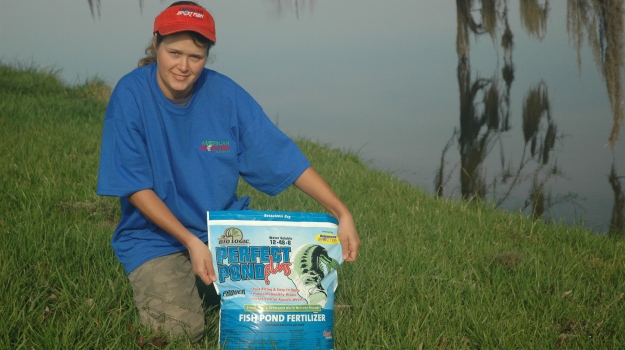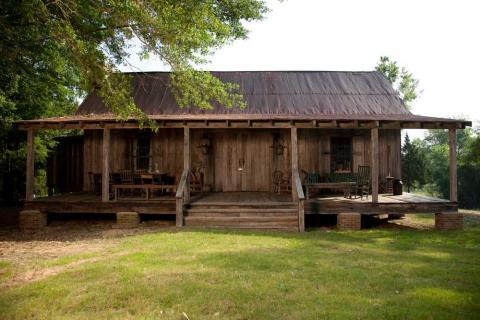By Don C Keller
All existing lakes and ponds containing both largemouth bass and bluegill will benefit significantly from a few basic and cost effective management techniques. A little knowledge coupled with some common sense will turn your lake into a great place to fish. One of the most important and economical techniques to improve the fishing in your lake is pond fertilization. I will explain why this is important, when to fertilize, how pond fertilizer works and when NOT to fertilize.

POND FERTILIZATION
Applying the proper pond fertilizer to a lake has the same effect as fertilizing your garden, your lawn or your agricultural crops; it increases your production. In fact, research into ponds has proven that pounds of fish produced may be increased 300 percent or more by proper fertilization. Clear, infertile ponds and lakes may have a total carrying capacity (total pounds of all species and sizes of fish) of less than 50 pounds of fish per acre. Well-fertilized lakes may produce 250 pounds or more of total fish per acre, providing many more opportunities for catching quality-size fish.
How does this happen? Pond fertilizer increases the small, green, single-cell plants called phytoplankton (this is what gives your pond a green tint). Tiny insects called zooplankton eat the phytoplankton. These little insects are eaten by larger insects, which are eaten by bluegill. The bluegills are eaten by bass and BAM! You have a great fishing hole. The more food you produce from fertilization, the more fish you can grow.
 BioLogic now has a new type of concentrated fertilizer called Perfect Pond Plus. This is a totally dissolvable powder or crystalline fertilizer, which requires no mixing, no platforms and only five pounds per acre to apply. Perfect Pond Plus (12-48-8) contains a micronutrient package beneficial for many crops. This fertilizer can be broadcast from the bank or pier or may be poured from the side of a boat. A five acre pond requires only 25 pounds. Pond fertilization could not be easier.
BioLogic now has a new type of concentrated fertilizer called Perfect Pond Plus. This is a totally dissolvable powder or crystalline fertilizer, which requires no mixing, no platforms and only five pounds per acre to apply. Perfect Pond Plus (12-48-8) contains a micronutrient package beneficial for many crops. This fertilizer can be broadcast from the bank or pier or may be poured from the side of a boat. A five acre pond requires only 25 pounds. Pond fertilization could not be easier.
WHEN NOT TO FERTILIZE
Every spring during the months of April and May, I get several calls from pond owners who seemed to be overwhelmed with vegetation problems. They usually state that they began fertilizing in early March and had difficulty establishing a desirable plankton bloom (green color). What they fail to tell me is that there was some vegetation in the pond when they began fertilizing. The reason they could not get a good bloom was because the vegetation was sucking up all the fertilizer.
All vegetation responds to fertilizer, sunlight, and moisture. When you go to your pond in late February or early March to begin fertilizing, you should first walk around the perimeter and see if you observe any unwanted vegetation growing in the shallows. If you don’t see any, but you have had a problem in years past, I would suggest you tie on a weighted lure to your casting rod line, cast out to deep water, and drag the lure across the bottom. If it comes back clean, go ahead and fertilize.
I have seen some lakes that did not have vegetation on the edges but would have rooted plants growing in six to eight feet of water. These weeds were difficult to see from the shoreline. Once these lakes were fertilized, the vegetation seemed to explode and would soon top out at the surface. Weed treatment then becomes very expensive and may have to be handled by a professional.
If vegetation is observed, the first thing you should do is get a sample and have it identified. If there is not a fisheries office near you, then take a weed sample and put it in a zip lock bag and FedEx it to a fisheries consultant. Once the plant is identified, a chemical treatment can be recommended. The water temperature needs to be more than 60 degrees F for the chemical to work properly.
I have often heard the statement from perplexed pond owners “I thought if I fertilized, I wouldn’t have a moss problem.” Well, this is partially true. The main purpose of fertilizing is to increase the food supply to your fish. This is done by first creating a phytoplankton bloom, which imparts a green color to the water. This green color also creates a shading effect which blocks out the sunlight and prevents unwanted vegetation from developing if none were present when the fertilizing began.
IF NONE WERE PRESENT is the key phrase here. If you do have filamentous algae (moss) along the edges or rooted vegetation, fertilizer will stimulate it to grow just as fertilizer will make the weeds in your garden grow. You can’t put out a fire by throwing gasoline on it.
Grass carp are a very useful tool but keep in mind that they are cold blooded and their body temperature is the same as the pond water. Therefore they will eat much more when the water temperature warms up. If you wait for them to clean up the weeds, you may have to delay your fertilization for several months, which will also slow the growth of your sport fish.

SUMMARY FOR FERTILIZATION
- Visit the pond and see if any vegetation is present.
- If vegetation is found, have it identified and a treatment recommended
- Check the water temperature and once it reaches 60 F, treat with the correct herbicide.
- Add grass carp to keep the problem from re-occurring.
- Begin fertilizing when the weeds are dead or disappeared.
- Remember, “A stitch in time, saves nine!”



























